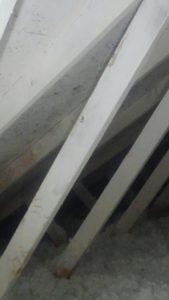Here are some of the Frequently Asked Questions we get about mold, mold remediation, and the product we use to remove mold from your home or business (Calbrite)
WHY IS CALBRITE NOT REGISTERED WITH THE EPA?
- Calbrite is a non-toxic product.
- only products that are considered poisonous, re: pesticides need to register with the EPA.
WHAT ARE SOME OF THE DANGERS OF USING PRODUCTS THAT ARE POISONOUS ON MOLD?
- cancer,
- reproductive effects,
- neurological effects, and
- acute and chronic toxic effects.
WHAT IS MOLD?
- mold is a life form that naturally exists on moist surfaces
- it will start growing within 48 hours after landing on a wet surface
- mold survives on cellulose, a material found in wood, papers and many other building materials
WHAT IS A MOLD INSPECTION?
- mold inspection is the process of thoroughly inspecting and mold testing a home, apartment, business or other dwelling for the presence of water problems, higher than normal levels of mold spores, or serious levels of mold infestation.
- mold collection means a certified mold inspector collects direct physical samples or takes indoor air samples so that mold samples can be grown in a lab in culture plates if necessary, to produce full grown mold colonies for analysis and mold identification purposes.
WHAT ARE SOME THINGS THAT ARE LOOKED AT IN AN INSPECTION?
- do any of the homes residents suffer from any of the most frequent symptoms of mold infestation?
- are there shrubs and trees growing too close to the home?
- is the land around the building sloping away from the building?
- is the roof in good shape?
- in the attic are water stains or visible mold growth?
- are there obvious signs of water leaks or mold growth in water oriented areas such as the bathroom or kitchen?
- are there water stains in any of the other rooms, ceiling, walls, flors or on furniture?
- is there hidden moisture inside wall cavities, under floors, or behind tiles?
- has the property experienced roof leaks, failed foundations, floods, etc.
- is it located in a flood zone?
- is the humidity of the crawlspace, basement or attic higher than 50%.
- are there elevated levels of mold spores in the air?
- is there mold contamination inside the building’s HVAC system and ducts?
WHAT ARE SOME COMMON MOLD SYMPTOMS?
- sneezing
- runny nose
- hay fever symptoms
- skin rash
- flu like symptoms and fever
- worsened asthma
- hypersensitivity pnemionitis-like bacteria (uncommon_
WHAT ARE SOME IRRITANT EFFECTS?
- eyes
- skin
- nose
- lungs
- burning sensation
- opportunistic infections: aspergillus fumigatus has been known to infect the lungs of immuno-compromised individuals as has trichoderma in ic children
WHAT ARE MOLD TOXINS?
- mold can produce toxic substances called mycotoxins. these can be on or in spores. more than 200 have been identified at this time. exposure pathways include inhalation, ingestion or skin contact. these can cause health problems
- ingestion of aflavatoxin b can cause liver cancer. this and asperigllus parasiticus are some of the most potent carcinogens.
- health effects attributed to inhalation of mycotoxins have been reported including mucous membrane irritation, skin rash, nausea, immune system suppression, chronic liver damage, chronic central nervous system damage, endocrine effects and cancer.
HOW DOES MOLD SPREAD?
- mold spores are tiny (2-10 um) and are naturally present indoors and outdoors in the air. mold reproduce by the means of spores. some molds have spores that are easily disturbed but others have sticky spores that cling and are dislodged by brushing. spores may remain able to grow for years after they are produced. whether or not the mold spores are alive, their allergens can remain so for years
WHAT ARE PROBLEMS MOLD CAN CAUSE?
- mold destroys the surface it grows on
- exposure to mold spores can cause allergic reactions
- airway problems
- dank air quality
- musty odor
- health problems
WHAT ARE SOME COMMON CAUSES OF MOISTURE PROBLEMS?
- roof leaks
- improper landscape grading
- leaking gutters
- condensation on pipes
- cracked foundations
- unvented combustion appliances
ARE THERE ANY FEDERAL REGULATION GOVERNING MOLD REMEDIATION?
- no, there are not any regulations currently governing mold remediation. there are recommended guidelines for conducting safe mold remediation.
HOW QUICKLY CAN MOLD START GROWING?
- mold can start growing within 48 hours if a moisture problem is not fixed and the dampness thoroughly dried
WHY IS BLEACH INEFFECTIVE?
- bleach is a biocide that is harmful to humans and can feed a mold colony. bleach only discolors the surface.
- it is too diluted to kill mold permanently and will only discolor surface mold
- the longer bleach is on supermarket shelves the more it loses its potency. 50% loss in killing capacity during its first 90 days on the shelf. chlorine escapes through the walls of the container
- *the ion structure of chlorine prevents it from penetrating porous materials. it only stays on the surface and mold has enzyme roots digging deep into the materials surface.
- bleach is not approved to kill mold.
At Clean Green Restoration we offer our services in the Pacific Northwest including mold remediation in Olympia and mold remediation in Tacoma. Call us today if you would like to learn more or if you would like to schedule an appointment at your home or business


